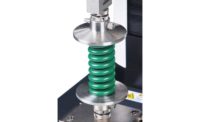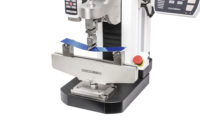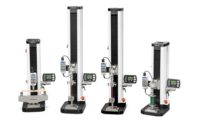Nondestructive testing (NDT) is a type of testing that allows for the examination or analysis of materials and components without sacrificing their usefulness. Nondestructive testing techniques are also utilized to detect, characterize, or measure damage to a material. The purpose of NDT is to inspect a component in a safe, reliable, and cost-effective manner without causing damage to equipment or interruption to manufacturing operations.
You may already be familiar with some NDT technologies such as X-ray or ultrasound in the medical industry. X-rays can evaluate bones for fractures, and ultrasounds can evaluate a developing fetus, a person’s abdominal and pelvic organs, muscles and tendons, or their heart and blood vessels
In industry, NDT testing can often be more complex. Some popular NDT tests are magnetic particle testing, liquid penetrant testing, radiographic testing, ultrasonic testing, or electromagnetic testing. Many of these tests are performed within the oil and gas industries, as well as chemical, automotive, aerospace and defense.

A compression test is performed on a spring. Source: Mark-10
The focus here is on nondestructive compression force testing, an important collection of test methods that help quality control professionals assess and ensure product quality.
What Is Compression Testing?
Compression tests are used to evaluate materials and components by compressing, crushing, squashing or flattening them. This type of test can establish the resistance of a material and its ability to recover after a specified compressive force is applied or held over a defined period of time. Typical types of compression tests include flexure/bend, spring, and crush. Although compression testing is frequently done to a breaking force or limit like the “crush” type, we will take a look at some nondestructive applications.
Nondestructive Testing with Springs
The first application that comes to mind when thinking of compression testing is spring testing. Springs are used in many everyday applications, such as pens, toys, mountain bikes, automobiles, home furnishings, and medical devices. A spring can be evaluated to determine its characteristics and performance, ensuring that it will perform over the course of the intended product life cycle. Product designers rely on these specifications to choose the correct spring for their design. Quality inspectors are interested in batch quality and consistency of manufacture for each spring.
It is important to measure several parameters when testing springs such as spring rate, spring load, load at displacement and displacement at load. The spring rate will often be calculated as part of a nondestructive test. The calculation can be determined by Hooke’s Law, which relates the force exerted by a spring to the distance it is stretched or compressed by a spring constant, k, measured in force per length.
The equation for Hooke’s Law is
F = -kx
Where
x = the displacement of the spring’s
end from its equilibrium
F = the force applied to the spring
k = the spring constant
While Hooke’s Law only applies to some materials under certain loading conditions, helical springs perform according to Hooke’s Law in most cases.
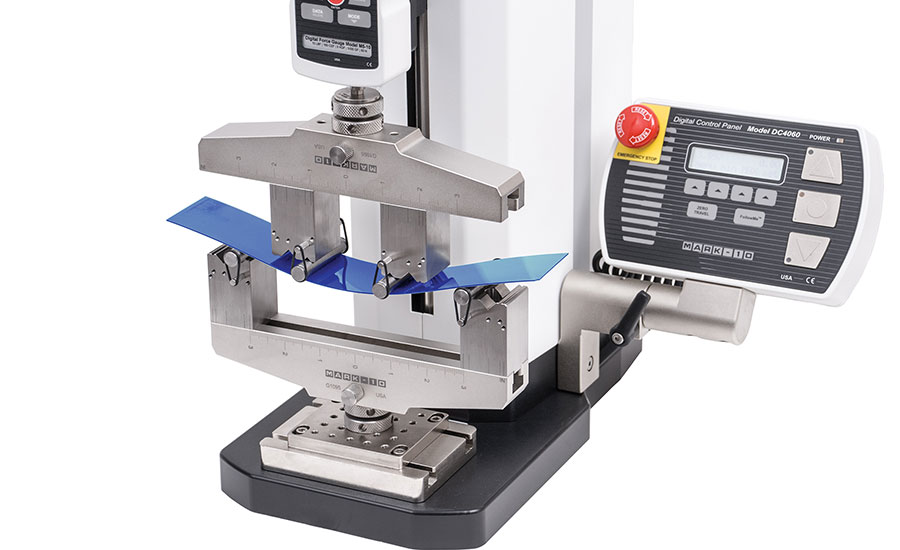
A 4-point bend test performed on a plastic sample helps shed light on its performance characteristics while preserving its integrity. Source: Mark-10
During a compression spring test, the sample will generally be compressed to a specified height, and the force will be measured at that point. Using the equation from Hooke’s Law, the spring rate is calculated.
Bending/Flexural Testing
Generally a flexure test such as a three or four-point bend test is run until the sample experiences failure, but there may be some exceptions where such a test can be used in a nondestructive manner. One example is measuring the flex force in a ski to determine optimal ski selection. By flexing a ski behind the balance point or approximate location of the ball of the foot, force measurement data can be collected and combined with camber distance (ski arch) and camber height. With this data, a ski company can characterize various ski models and match them to the preferences of a skier. The force vs. camber data is analyzed to determine each ski’s optimum snow condition, boot binding position, and wax type.
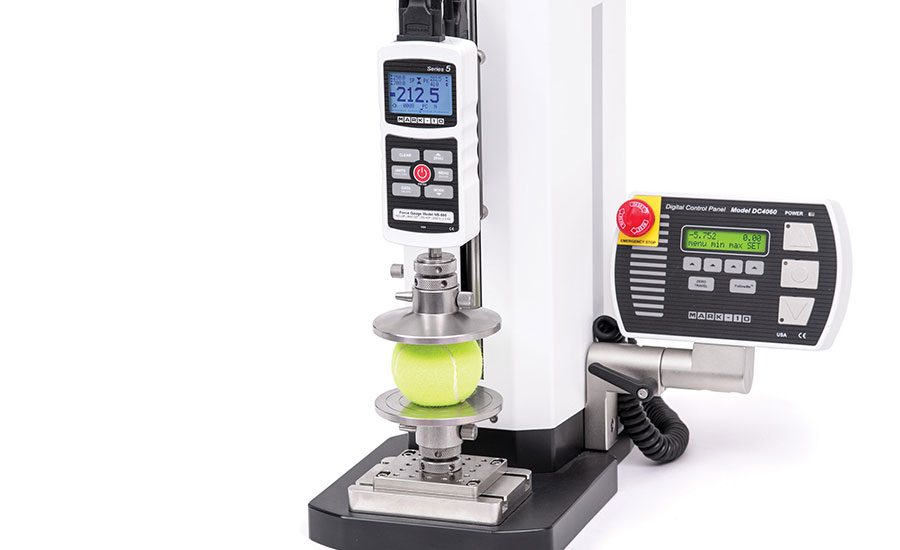
A typical compression force testing system consists of a test stand, force gage, and application-specific grips and fixtures. Many compression testers are capable of tension measurement as well. Source: Mark-10
Nondestructive Testing in the Automotive and Electronics Industries
There are many NDT compression applications within both the automotive and electronics industries. Often, the two industries overlap as more electronics are integrated into vehicles. Force measurement can ensure vehicle performance and safety with NDT compression tests such as switch force activation and turn stalk activation. Each is measured using a force gage and a rubber tip attachment that can simulate a human finger in compression testing.
Nondestructive Testing For Sporting Goods
Among the many possible tests in the wide world of sports, there are compression test methods for golf and tennis balls. In both industries, balls must pass stringent specifications set forth by governing bodies to be allowable for tournament play. These NDT tests are designed to compress each ball to a specified load at which point the amount of movement is measured. This ensures consistent performances among the samples.
Benefits of Nondestructive Compression Testing
NDT compression testing allows for a material or component to be tested and utilized in its intended application, provided the sample is within acceptable limits. It can determine consistency in manufacture, facilitate the design process, reduce costs, and ensure compliance with industry standards.
Equipment needed for NDT Compression Testing
1. A manual or motorized test stand
A test stand produces the force necessary for a test. Although a manual or motorized test stand may be used, it is important to understand whether a high degree of repeatability or consistent rate of speed is needed. For many spring tests, a simple manual test stand may provide the most economical solution. If the test requires constant speed while applying a load to the specimen, a motorized test system will produce better repeatability.
2. Force gage
A force gage measures the force produced on the test sample. It typically displays force units in pound-force (lbF), Newtons (N), or kilogram-force (kgF). Choose an instrument with a force capacity that is as close as possible to the maximum expected force. It is considered best practice to select a force gage between 20% and 80% margin of its capacity for best accuracy and safety.
3. Grips or fixtures
Choosing the correct grips or attachments is critical to the success of a measurement system. Precise load alignment during force testing is dependent on the grips, attachments, or fixtures used to retain the sample.
For NDT compression spring tests, circular compression plates are suitable for testing. Choose a compression plate that is self-leveling, smooth, and rated for the expected load and diameter of the sample. In a bend/flexural test, 3-point and 4-point specialized bend fixtures are available. In a 3-point bend test, a base-anvil combination is used. Two bases are utilized in 4-point bend testing.
A rubber-faced probe is another common attachment used in NDT compression testing. It can be employed to simulate a finger for testing pushbuttons and membrane switches.
4. Software
Results can be viewed, stored, exported, and analyzed depending on each application requirement. High quality, computer-controlled testing systems and most motorized systems include capabilities to transfer data to a PC or statistical printer. Consider a software package that plots data, calculates statistics, generates reports, or provides other analysis tools for the most insight into the performance of the sample.
5. Safety shield
A safety shield is recommended to protect the operator from flying objects or debris that may travel from the testing area, as well as to protect against limbs, hair, or clothing from becoming entangled in the test area. A clear, shatterproof polycarbonate material is best. Investing in a pair of safety goggles is also a sensible idea.
The Bottom Line
Nondestructive compression force measurement yields a wealth of valuable information about the characteristics and behavior of samples in virtually every industry. Because samples are not sacrificed, manufacturers can save a considerable amount of costs and scrap, benefiting their bottom line.

